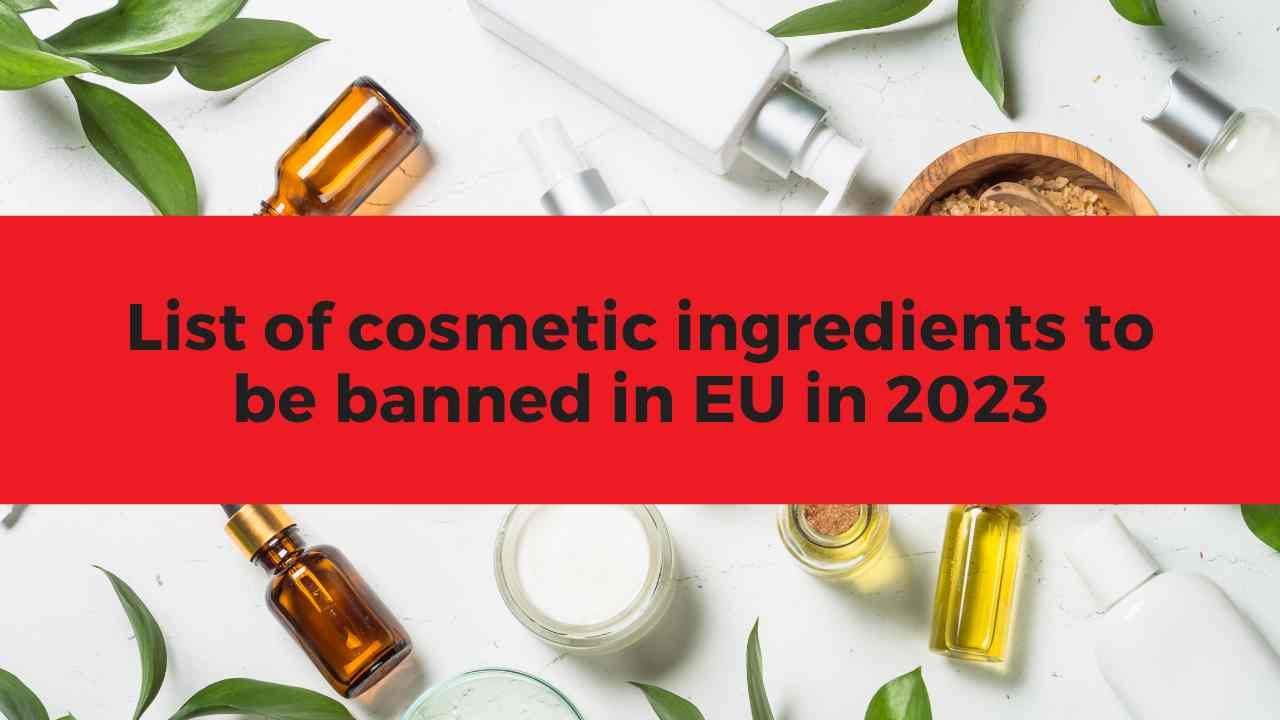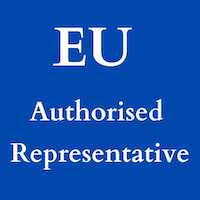We’ve put together a list of cosmetic ingredients scheduled to be banned in the EU in 2023. Do you have cosmetics that contain any of these ingredients? Cross check your formulations against this list to identify cosmetics to be reformulated. Search the list by chemical name, CAS or EC number.
Draft laws
The list of cosmetic ingredients below are scheduled to be added to Annex II of EU cosmetic regulation. The laws are still in draft (see links below for draft legislation). Cosmetic ingredients listed in Annex II are not permitted for use in cosmetics in the EU. The update does not currently apply to the United Kingdom.
Deadline
Cosmetic manufactures should aim to sell through products containing a banned ingredient by 1st December 2023. From 1st December 2023 no cosmetic should contain a listed ingredient.
List of cosmetic ingredients banned in EU in 2023
Below is a list of cosmetic ingredients scheduled to be banned in Europe in 2023 (yellow table). A list of cosmetic ingredients banned in 2022 follows this list (blue table).
| Substance Name | CAS Number | EC Number |
| Ammonium bromide | 12124-97-9 | 235-183-8 |
| Dibutyltin bis(2-ethylhexanoate) | 2781-10-4 | 220-481-2 |
| Dibutyltin di(acetate) | 1067-33-0 | 213-928-8 |
| Tellurium dioxide | 7446-07-3 | 231-193-1 |
| Barium diboron tetraoxide | 13701-59-2 | 237-222-4 |
| 2,2-dimethylpropan-1-ol,tribromo derivative; 3-bromo-2,2-bis(bromomethyl)propan-1-ol | 36483-57-5/ 1522-92-5 | 253-057-0/- |
| 2,4,6-tri-tert-butylphenol | 732-26-3 | 211-989-5 |
| 4,4’-sulphonyldiphenol; bisphenol S | 80-09-1 | 201-250-5 |
| Benzophenone | 119-61-9 | 204-337-6 |
| Quinoclamine (ISO); 2-amino-3-chloro-1,4- naphthoquinone | 2797-51-5 | 220-529-2 |
| Perfluoroheptanoic acid; tridecafluoroheptanoic acid | 375-85-9 | 206-798-9 |
| methyl N-(isopropoxycarbonyl)-L-valyl- (3RS)-3-(4-chlorophenyl)-β-alaninate; valifenalate | 283159-90-0 | 608-192-3 |
| 6-[C12-18-alkyl-(branched, unsaturated)-2,5- dioxopyrrolidin-1-yl]hexanoic acid, sodium and tris(2-hydroxyethyl)ammonium salts | – | 701-271-4 |
| Fluopicolide (ISO); 2,6-dichloro-N-[3-chloro- 5-(trifluoromethyl)-2- pyridylmethyl]benzamide | 607-285-6 | 239110-15-7 |
| N-(2-nitrophenyl)phosphoric triamide | 874819-71-3 | 477-690-9 |
| N-(5-chloro-2-isopropylbenzyl)-N– cyclopropyl-3-(difluoromethyl)-5-fluoro-1- methyl-1H-pyrazole-4-carboxamide; isoflucypram | 1255734-28-1 | 811-438-4 |
| Reaction mass of 3-(difluoromethyl)-1-methyl- N-[(1RS,4SR,9RS)-1,2,3,4-tetrahydro-9- isopropyl-1,4-methanonaphthalen-5- yl]pyrazole-4-carboxamide and 3- (difluoromethyl)-1-methyl-N-[(1RS,4SR,9SR)- 1,2,3,4-tetrahydro-9-isopropyl-1,4- methanonaphthalen-5-yl]pyrazole-4- carboxamide [>78% syn isomers <15% anti isomers relative content]; isopyrazam | 881685-58-1 | 632-619-2 |
| Margosa, ext. [from the kernels of Azadirachta indica extracted with water and further processed with organic solvents] | 84696-25-3 | 283-644-7 |
| Cumene | 98-82-8 | 202-704-5 |
| 2-ethyl-2-[[(1-oxoallyl)oxy]methyl]-1,3- propanediyl diacrylate; 2,2- bis(acryloyloxymethyl)butyl acrylate; trimethylolpropane triacrylate; | 15625-89-5 | 239-701-3 |
| Pentapotassium 2,2’,2’’,2’’’,2’’’’-(ethane-1,2- diylnitrilo)pentaacetate | 7216-95-7 | 404-290-3 |
| N- carboxymethyliminobis(ethylenenitrilo)tetra(a cetic acid); Pentetic Acid (INCI) | 67-43-6 | 200-652-8 |
| Pentasodium (carboxylatomethyl)iminobis(ethylenenitrilo)te traacetate; Pentasodium Pentetate (INCI) | 140-01-2 | 205-391-3 |
| Acetamiprid (ISO); (1E)-N-[(6-chloropyridin- 3-yl)methyl]-N’-cyano-N– methylethanimidamide; (E)-N1-[(6-chloro-3- pyridyl)methyl]-N2-cyano-N1- methylacetamidine | 135410-20-7/ 160430-64-8 | 603-921-1/ 682-791-8 |
| Pendimethalin (ISO); N-(1-ethylpropyl)-2,6- dinitro-3,4-xylidene | 40487-42-1 | 254-938-2 |
| Bentazone (ISO); 3-isopropyl-2,1,3- benzothiadiazine-4-one-2,2-dioxide | 25057-89-0 | 246-585-8’ |
Other changes
Entry 1024 of Annex II is replaced by the following:
“2-ethylhexanoic acid and its salts with the exception of those specified elsewhere in Annex VI to Regulation (EC) No 1272/2008”
CAS: 149-57-5/-
EC: 205-743-6/-’
Change comes into effect from 1st December 2023.
What manufacturers need to do and by when
In order to comply with the ban, cosmetic manufactures must cease to sell cosmetics with listed ingredients from 1st December 2023. Offending cosmetics must be removed from sale by this deadline.
Want to learn about cosmetic regulation? Check out cosmetic regulation and testing course

Source
Learn more by reading the draft legislation:
List of ingredients to be banned
Background
The EU Cosmetic Regulation No 1272/2008 sets a standard for categorizing substances as carcinogenic, mutagenic, or toxic for reproduction (CMR). The level of evidence of a substance’s CMR properties determines whether it’s classified as category 1A, 1B, or 2.
CMRs prohibited
Regulation (EC) No 1223/2009’s Article 15 prohibits the use of CMR substances categorized as 1A, 1B, or 2 in cosmetic products. However, an exception is made if the conditions outlined in Article 15(1) or 15(2) are met.
CMRs listed in Annex II
To create consistency in implementing the prohibition of CMR substances and ensure legal certainty, all CMR substances should be included in the list of prohibited substances in Annex II to Regulation (EC) No 1223/2009. Additionally, any relevant substances should be removed from the lists of restricted or allowed substances in Annexes III to VI. Any amendments should be made if the conditions outlined in Article 15(1) or 15(2) are met.
Impact on CPSR
Do you have a cosmetic that contains a banned ingredient? Don’t forget you’ll need to update your cosmetic safety assessment. It is likely that a full new CPSR will be required and attract the full CPSR fee.
EU Annex II List of prohibited ingredients
Download the official EU list in excel format here. (Last update 16th March 2023)
Cosmetic ingredients banned in EU in 2022
Here’s a list of ingredients already banned in the EU last year (40 ingredients). No cosmetic on the EU market today should contain any of the listed ingredients.
| Substance Name | CAS Number | EC Number |
| (1RS,2SR,5RS)-2-(4-Chlorobenzyl)-5-isopropyl-1-(1H-1,2,4-triazol-1-ylmethyl) cyclopentanol;Ipconazole, (1R,2S,5R)-rel- | 115850-69-6 | – |
| (1RS,2SR,5SR)-2-(4-Chlorobenzyl)-5-isopropyl-1-(1H-1,2,4-triazol-1-ylmethyl) cyclopentanol;Ipconazole, (1R,2S,5S)-rel | 115937-89-8 | – |
| (5-Chloro-2-methoxy-4-methyl-3-pyridyl)(4,5,6-trimethoxy-o-tolyl)methanone | 688046-61-9 | 692-456-8 |
| (RS)-1-{1-Ethyl-4-[4-mesyl-3-(2-methoxyethoxy)-o-toluoyl]pyrazol-5-yloxy}ethyl methyl carbonate | 1101132-67-5 | 701-225-3 |
| 2,2-Bis(bromomethyl)propane-1,3-diol | 3296-90-0 | 221-967-7 |
| 2-(4-tert-Butylbenzyl) propionaldehyde | 80-54-6 | 201-289-8 |
| 2-Methoxyethyl acrylate | 3121-61-7 | 221-499-3 |
| 3-(difluoromethyl)-1-methyl-N-(3′,4′,5′-trifluorobiphenyl-2-yl) pyrazole-4-carboxamide | 907204-31-3 | 620-041-3 |
| 3-Methylpyrazole | 1453-58-3 | 215-925-7 |
| 4-Methylpentan-2-one | 108-10-1 | 203-550-1 |
| 5-Fluoro-1,3-dimethyl-N-[2-(4-methylpentan-2-yl)phenyl]-1H-pyrazole-4-carboxamide | 494793-67-8 | 619-823-7 |
| 6,6′-di-tert-Butyl-2,2′-methylenedi-p-cresol | 119-47-1 | 204-327-1 |
| Azamethiphos (ISO) | 35575-96-3 | 252-626-0 |
| Bis(2-(2-methoxyethoxy)ethyl)ether | 143-24-8 | 205-594-7 |
| Bis(α,α-dimethylbenzyl) peroxide | 80-43-3 | 201-279-3 |
| Desmedipham (ISO) | 13684-56-5 | 237-198-5 |
| Dibenzo[def,p]chrysene | 191-30-0 | 205-886-4 |
| Dichlorodioctylstannane | 3542-36-7 | 222-583-2 |
| Diisooctyl phthalate | 27554-26-3 | 248-523-5 |
| Dimethomorph (ISO) | 110488-70-5 | 404-200-2 |
| Dioctyltin dilaurate | 3648-18-8 | 222-883-3 |
| Flurochloridone (ISO) | 61213-25-0 | 262-661-3 |
| Hymexazol (ISO) | 10004-44-1 | 233-000-6 |
| Imazamox (ISO) | 114311-32-9 | 601-305-7 |
| imiprothrin (ISO); reaction mass of [2,5-dioxo-3-(prop-2-yn-1-yl)imidazolidin-1-yl]methyl (1R,3S)-2,2-dimethyl-3-(2-methylprop-1-en-1-yl)cyclopropanecarboxylate and [2,5-dioxo-3-(prop-2-yn-1-yl)imidazolidin-1-yl]methyl (1R,3R)-2,2-dimethyl-3-(2-methylprop-1-en-1-yl)cyclopropanecarboxylate | 72963-72-5 | 428-790-6 |
| Ipconazole (ISO) | 125225-28-7 | 603-038-1 |
| Iprovalicarb (ISO) | 140923-17-7 | 604-209-3 |
| Mesotrione (ISO) | 104206-82-8 | 600-533-4 |
| N-(Hydroxymethyl)acrylamide | 924-42-5 | 213-103-2 |
| N-Methoxy-N-[1-methyl-2-(2,4,6-trichlorophenyl)-ethyl]-3-(difluoromethyl)-1-methylpyrazole-4-carboxamide | 1228284-64-7 | 817-852-1 |
| N-{2-[[1,1′-bi(Cyclopropyl)]-2-yl]phenyl}-3-(difluoromethyl)-1-methyl-1H-pyrazole-4-carboxamide | 874967-67-6 | 688-331-2 |
| Paclobutrazol (ISO) | 76738-62-0 | 616-379-6 |
| Pyrithione zinc | 13463-41-7 | 236-671-3 |
| Silicon carbide, fibrous | 308076-74-6 | – |
| Silicon monocarbide | 409-21-2 | 206-991-8 |
| Stannane, dioctyl-, bis (coco acyloxy) derivs. | 91648-39-4 | 293-901-5 |
| Tetrafluoroethylene | 116-14-3 | 204-126-9 |
| Thiamethoxam (ISO) | 153719-23-4 | 428-650-4 |
| Tris(2-methoxyethoxy) vinylsilane | 1067-53-4 | 213-934-0 |
| Triticonazole (ISO) | 138182-18-0 | – |
Categories
Recent Posts
- 3D Printing in Pharmaceuticals for Personalised Medicine 19th November 2025
- AI Agents: Oxford PharmaGenesis & OriginTrail Unveil Plan for Clinical Ecosystem 6th September 2025
- Latest EU Regulatory Changes for Retinol in Cosmetics 27th August 2025
- Tea Tree Oil Safety: SCCS Draft Opinion Explained 31st July 2025
- Misinformation: If you can remember it then it must be true, right? 4th June 2025
- The Dunning-Kruger Effect and Vaping: Why We’re So Sure About What We Don’t Know 15th May 2025
- Cognitive Ease: Why Simple Vaping Claims Win Over Complexity 14th May 2025
- Vaping vs. Smoking: The Misconception Gap 13th May 2025
Archives
- November 2025
- September 2025
- August 2025
- July 2025
- June 2025
- May 2025
- January 2025
- July 2024
- March 2024
- February 2024
- January 2024
- October 2023
- August 2023
- July 2023
- April 2023
- March 2023
- February 2023
- January 2023
- November 2022
- October 2022
- June 2022
- March 2022
- April 2021
- February 2020
- September 2018
- July 2018
- June 2018
- May 2018
- April 2018
- April 2017
- February 2017
What We Do
We are a London-based regulatory affairs consultancy providing services to the e-cigarette, cosmetic, biocide, pharmaceutical and medical device industry. We help e-cigarette companies comply with the Tobacco Products Directive and pharmaceutical companies obtain and maintain medical product licences. We also offer UKAS accredited biocide and analytical testing services.



Comments are closed here.